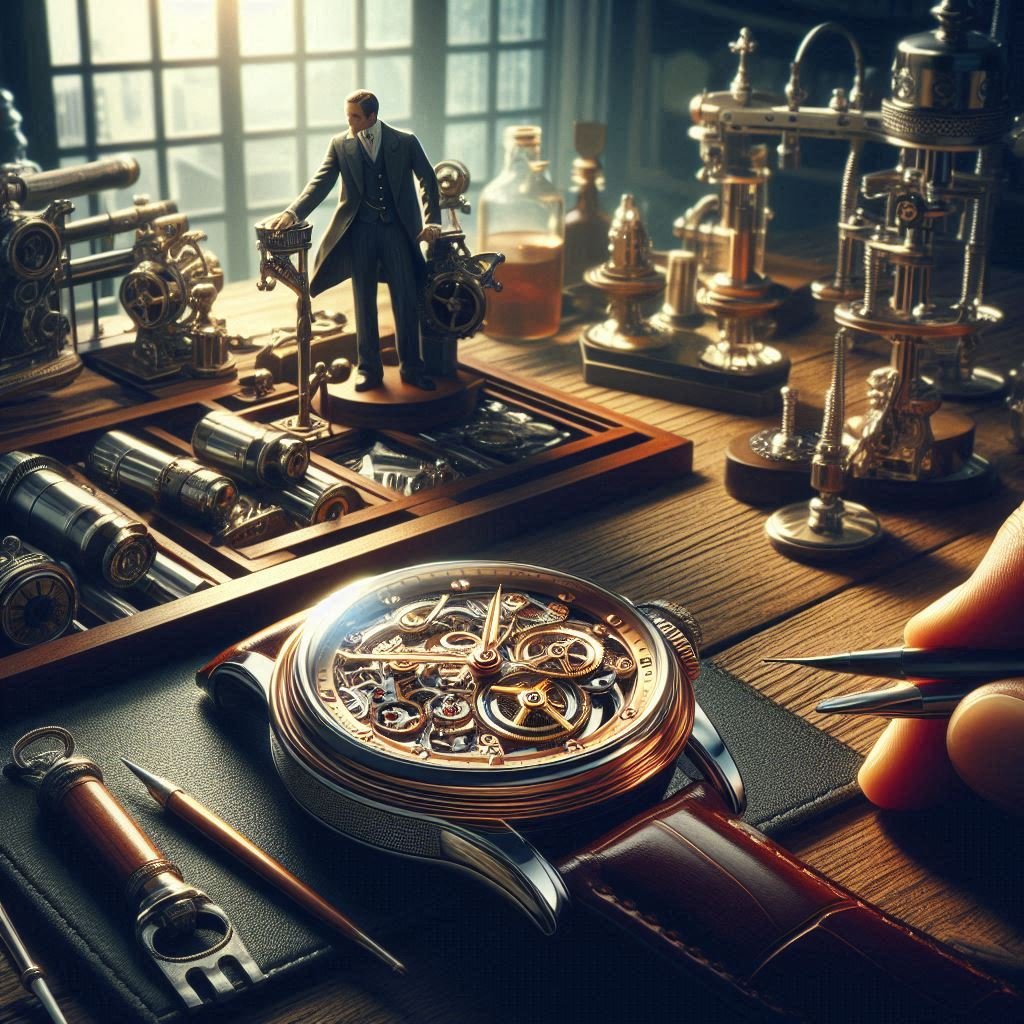I. Introduction: The Timeless Allure of Luxury Watchmaking
In an era dominated by digital gadgets, luxury watchmaking stands out as a testament to enduring craftsmanship and sophisticated engineering. Did you know that creating a single handmade luxury watch can take over a year, involving meticulous attention to detail and the expertise of master artisans? These timepieces are not merely tools for telling time; they are symbols of status, artistry, and technological prowess. This article explores the rich heritage, intricate processes, and future trends of luxury watchmaking, highlighting how top brands maintain their prestige in a competitive market.
“Exploring the Art and Tradition of Luxury Watchmaking: Timeless Elegance”. This table provides a clear structure, enhancing organization and readability.
| Heading |
|---|
| I. Introduction |
| II. A Legacy of Precision: The History of Handcrafted Luxury Watches |
| III. Notable Brands Exemplifying Traditional Luxury Watchmaking |
| IV. The Microprocess: From Design to Delivery |
| V. Comparative Analysis of Top Luxury Watch Brands |
| VI. Market Trends and Future Projections in Luxury Watchmaking |
| VII. Innovative Complications in Audemars Piguet Watches |
| VIII. The Human Element: Master Craftspeople and Their Roles |
| IX. The Enduring Appeal of Handmade Luxury Watches |
| X. Conclusion |
| Disclaimer |
II. A Legacy of Precision: The History of Handcrafted Luxury Watches
Luxury watchmaking boasts a storied history that dates back centuries. The evolution from early pocket watches in the 17th century to today’s sophisticated wristwatches showcases the industry’s commitment to traditional craftsmanship and precision engineering. Pioneers like Abraham-Louis Breguet introduced innovations such as the tourbillon, revolutionizing timekeeping accuracy. Esteemed brands like Patek Philippe, Rolex, and Audemars Piguet have preserved these traditions, blending them seamlessly with modern advancements to create timeless masterpieces.

III. Notable Brands Exemplifying Traditional Luxury Watchmaking
The luxury watch industry is home to several iconic brands, each with its unique legacy and specialties:
- Patek Philippe: Renowned for its complex mechanical movements and grand complications, such as perpetual calendars and minute repeaters. Patek Philippe emphasizes intricate hand-finishing and exclusivity.
- Rolex: Synonymous with precision and reliability, Rolex pioneered the robust Oyster case for water resistance. Iconic models like the Submariner and Daytona have become cultural symbols.
- Audemars Piguet: Creator of the Royal Oak, Audemars Piguet transformed the luxury sports watch market with innovative designs and advanced complications.
- A. Lange & Söhne: A German brand that emphasizes traditional watchmaking techniques and meticulous hand-finishing, offering elegant and precise timepieces.
- Jaeger-LeCoultre: Known for technical prowess and innovative designs like the Reverso, excelling in both simple and complex complications.
- Vacheron Constantin: One of the oldest luxury watch brands, celebrated for timeless designs and exquisite craftsmanship in movements and finishes.
- Blancpain: Famous for their diving watches, Blancpain combines tradition with innovation, focusing on classic designs that prioritize functionality.

IV. The Microprocess: From Design to Delivery
Creating a handmade luxury watch is an elaborate process that blends artistic vision with technical precision. This section breaks down each stage, highlighting the challenges and solutions watchmakers encounter, as well as the integration of sustainable and ethical practices.
- Design Phase: The journey begins with detailed sketches and prototypes. Designers refine every curve and line, selecting premium materials like gold, platinum, and rare gemstones. Challenges include ensuring aesthetic appeal while maintaining functionality and durability.
- Movement Construction: Often referred to as the “heart” of the watch, the movement is assembled with unparalleled precision. Master watchmakers meticulously craft and assemble hundreds of tiny components by hand. Ensuring sustainability, brands are increasingly sourcing conflict-free materials and incorporating recycled metals.
- Case and Dial Creation: The case is shaped and polished from precious metals, while the dial features hand-painted details, engravings, or gemstone settings. Integrating the movement into the case requires delicate precision to maintain both aesthetics and functionality.
- Finishing Touches: The final stage involves polishing, bevelling, and intricate detailing. Techniques like anglage (chamfering of edges) add depth and visual appeal, transforming the watch from a functional device into a work of art.

V. Comparative Analysis of Top Luxury Watch Brands
While many luxury watch brands share common traits, each distinguishes itself through unique approaches and strengths:
- Patek Philippe: Excels in highly complicated movements and hand-finishing, targeting collectors who value historical significance and exclusivity.
- Rolex: Focuses on durability and technical precision, appealing to both collectors and practical investors. Known for robust construction and high resale value.
- Audemars Piguet: Differentiates with avant-garde designs like the Royal Oak, blending cutting-edge design with traditional watchmaking to attract connoisseurs.
- Vacheron Constantin: Specializes in custom and ultra-complicated timepieces, catering to purists seeking classical design excellence.
- Jaeger-LeCoultre: Combines technical innovation with elegant design, offering a wide range of complications and styles.
VI. Market Trends and Future Projections in Luxury Watchmaking
The luxury watchmaking industry is evolving with emerging trends and technological advancements:
- Sustainability: Growing demand for ethical sourcing and eco-friendly production methods. Brands are adopting sustainable practices, such as using recycled materials and minimizing waste.
- Secondary Market Growth: The rise of the pre-owned market has transformed luxury watches into valuable investments. Brands like Rolex and Patek Philippe see their pre-owned models appreciate in value, leading to certified pre-owned programs.
- Customization and Personalization: Increasing consumer desire for personalized timepieces has led brands to offer bespoke options, allowing customers to tailor watches to their preferences.
- Digital Marketing and E-Commerce: Enhanced online presence and digital marketing strategies are expanding the reach of luxury watch brands, making them more accessible to a global audience.

VII. Innovative Complications in Audemars Piguet Watches
Audemars Piguet is renowned for its technical innovations, setting it apart from other luxury watch brands.
- Royal Oak Offshore: Introduced bold design elements and robust materials, redefining luxury sports watches with a blend of durability and elegance.
- Tourbillon des Indes: Features dual tourbillons displaying longitude and latitude, showcasing advanced precision in timekeeping.
- Gyromax: A self-winding movement utilizing an orbiting weight, enhancing the watch’s accuracy and reliability.
Compared to brands like Patek Philippe, which emphasizes classical complications, Audemars Piguet excels in merging innovative design with traditional craftsmanship, particularly in sporty yet sophisticated models.
VIII. The Human Element: Master Craftspeople and Their Roles
The creation of a handmade luxury watch is a collaborative effort involving a team of highly skilled artisans. Each specialist contributes their unique expertise:
- Designers: Envision the watch’s aesthetics and functionality.
- Master Horologists: Assemble the intricate movements, ensuring precision and reliability.
- Case Makers and Dial Artists: Craft and embellish the watch’s exterior, adding personalized touches through engravings and hand-painted details.
- Finishers: Apply the final polishing and detailing, perfecting the watch’s appearance.
Training and apprenticeship programs within these workshops ensure the preservation of traditional skills, passing down knowledge to future generations and maintaining the industry’s high standards.
IX. The Enduring Appeal of Handmade Luxury Watches
The enduring appeal of handmade luxury watches lies in their unique combination of artistry, precision, and heritage. These timepieces offer more than just timekeeping; they represent human ingenuity, dedication, and sophisticated engineering. Key factors contributing to their desirability include:
- Exclusivity: Limited production ensures that each watch is a rare and valuable possession.
- Investment Value: Luxury watches often appreciate in value, making them attractive investments.
- Emotional Significance: Many watches are passed down as heirlooms, carrying sentimental value through generations.
- Aesthetic Beauty: Intricate designs and superior craftsmanship make each watch a work of art.
In a digital age, the tangible quality and storied legacy of luxury watches continue to captivate collectors and enthusiasts alike.
X. Conclusion: Timeless Masterpieces
Luxury watchmaking epitomizes the pinnacle of craftsmanship and innovation. From the intricate movements and artistic dials to the ethical sourcing of materials, these timepieces are symbols of precision, beauty, and tradition. As the industry embraces sustainability and technological advancements, handmade luxury watches remain cherished as timeless masterpieces. Whether as investments, status symbols, or heirlooms, these watches continue to inspire and captivate for generations to come.
Disclaimer:
The content on this blog is for informational purposes only and is not intended as professional advice. We strive for accuracy but cannot guarantee the reliability of all information presented.”
If you find any incorrect information in the blog, please inform us.
“This article reflects the author’s opinions and was created with the assistance of artificial intelligence.”




